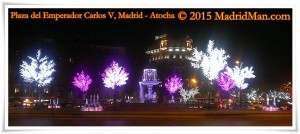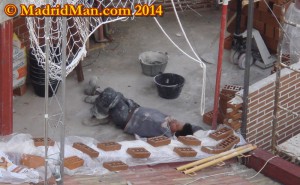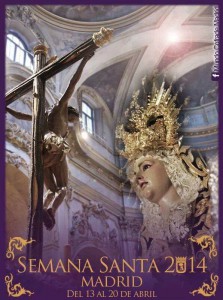Today, 15th of May 2012, is Madrid’s Patron Saint’s Day, San Isidro Labrador. It’s Madrid’s most “Castizo” day of the year with festival events throughout the city including concerts in “Las Vistillas”, a month long bullfight festival in the Plaza de Toros de Las Ventas, and period costumes, dances, and food in the Pradera de San Isidro.
Yesterday morning and this morning I went to Madrid’s Pradera de San Isidro – which is just in the adjacent neighborhood to where I live, not a 20-minute walk away. Today was hot, however, but not as hot as yesterday, I don’t think, probably ‘only’ reaching 85ºF/29ºC. But it’s a dry heat, right?
There’s LOTS to see, do, and eat in the Pradera de San Isidro. When you go, remember to take your patience, first and foremost. The Pradera is FULL of people walking in all directions while looking at a 90º angle to which they’re walking. Imagine a big State Fair in the USA and that’s what it’s like. Imagine some of those same people pushing baby strollers as if it were a snow-plow without brakes. You get the idea.
Protect yourself from the scorching Madrid sun. Take a hat or an umbrella or a handkerchief or make a paper hat out of the day’s newspaper because it’s hot and there’s little shade on the main strip. Beware of umbrella-carrying people pushing strollers and looking at a 90º angle to which they’re walking.
I LOVE seeing people, very young and very old, wearing period costumes from the late 1700s and early 1800s. There are “Chulapos” & “Chulapas” as well as the “Goyesca” costumes. I prefer the more common-man “Chulapo” costume to the somewhat upper-class “Goyesca” ones, though. The cutest of the cute are the little boys and girls in costumes.
RELIGION:
During the San Isidro Festival, one can visit the “Ermita del Santo” in the Pradera de San Isidro. I went the day BEFORE San Isidro, the 14th, and could walk directly into the Hermitage without waiting.
This same day, the 14th, I was also able to drink from the fountain of the aforementioned “Ermita del Santo”, which, as legend has it, its water has “healing powers”. I don’t know about that, but it did smell a bit odd, but not better or worse than the “hard” well-water I grew up on in rural Ohio. I did notice, however, that the glasses from which were were drinking were simply re-filled for the next person and not washed first. This, I noticed, AFTER drinking from the water glass. Hmmm…
The next day, today, the 15th and Madrid’s Patron Saint’s Day, the line for the “Ermita” was half-way down the hill and the line to drink the water went alllll the way down the hill, possibly spanning 400 meters.
At noon, the Catholic Mass started – and lasted about an hour. This takes place in the open-air, under the sun, and at the mid-point of the Pradera de San Isidro, essentially dividing the bars, restaurants and gaming stands in the upper portion from the sweets, “Ermita del Santo”, and “Castizo” dances in the lower portion. I have to wonder if it was logistically planned this way, dividing the “sinful” area from the puritan area. But no, surely not, this was just the flattest portion of the hill on which to install several hundred chairs and a stage.
FOOD:
There is ABSOLUTELY NO SHORTAGE of food at this festival. A LOT of meats are consumed here, be it rabbit, ribs, suckling pig, chicken, and sausages. AND the yummy fried foods like “chopitos“, “croquetas“, “patas bravas“, “calamares“, and “salmonetes“. And don’t forget the enormous paellas concocted here! Mmmm.. It makes me hungry just thinking about them. Most “stands” have the bar up-front at the street side and the restaurant tables in under shade tarps in the back. I’ve never eaten here, but have had one or two “Tinto de verano” drinks to cool off during the uphill, sun-drenched trek. Later, I had a headache.
Apart from the meal-type-foods, you also have the bread, cheese, and olive stands which serve you in to-go containers.
SWEETS:
“Rosquillas“. They look like donuts, but they’re not, although they are fried batter in a circle with a hole in the middle and topped with flavored, hardened sugars and syrups. As opposed to donuts, these fried dough is usually drier, not as moist, oftentimes harder, too.
Rosquillas can be eaten on-the-go, of course, but are more commonly eaten for “merienda” or breakfast. This year I bought 2-dozen and finished them within 3-days. I had help, of course. Check out the mature “Chulapa” at the far right of the below photo, she’s obviously enjoying hers on-the-go. If you click the photo and look closely, you can see the crumbs on her lips. MMmm.. Gooood.
DANCE:
There’s no lack of dancing going on on the streets of the Pradera de San Isidro. Sometimes they dance “El Chotis” and othertimes they dance a “pasodoble”, but the “El Chotis” is the most typical for this festival. For the most part, the man stands still while the woman spins him around slowly. Hmm.. Sounds familiar, right? The woman does all the work while the man just stands there. See video below of “El Chotis”.
So another San Isidro has come and gone – apart from the bullfighting festival which lasts to mid-June or so, many of which will be televised, but the photos, videos, and memories will last us at least until next year.
Happy San Isidro Day, Madrileños! I’m awaiting your end-of-holiday fireworks at 12 midnight, which I’ll happily watch from our building’s rooftop terraza. Man, I love Madrid.
UPDATE: I’ve just come down from the rooftop terraza after watching a spectacular showing of 15-minutes of end-of-festival fireworks. A great show in the dead-of-night to end Madrid’s most “Castizo” of holidays. Until next year!
Also read all year’s accounts of the San Isidro Festival in Madrid with lots of information, insights, photos and videos:
San Isidro 2013, San Isidro 2012, San Isidro 2011, San Isidro 2010, San Isidro 2009, San Isidro 2008
Share THIS on Facebook!




















San Isidro nació en Madrid , es de suponer que fuese el 4 de abril de 1082 . Según era mencionado en su época San Isidro poseía el don de serle fácil encontrar agua ( zahorí ). Algunos de los manantiales fueron marcados posteriormente como lugares mágicos, incluso algunos de ellos fue entendido como lugar de milagro. Contrajo matrimonio con María , mujer que procedía de Uceda (Guadalajara). Los asedios almorávides a la ciudad de Madrid hacen que la pareja huya a Caraquiz , en esta aldea María cuidaba de ermita de Nuestra Señora de la Piedad mientras él como labrador cuidaba de las tierras. En 1119 regresa a Madrid para vivir en una casa cercana a la Iglesia de San Andrés . El 30 de noviembre de 1172 muere en su casa y su mujer regresó a Caraquiz donde pasó sus últimos días. La muerte del santo hizo que su fama se acrecentara durante el siglo XV.
I cannot believe I never actually went to the main festival in 7 years of being in Madrid . My local high school in Salamanca barrio used to have a party in the open yard where all the kids and teachers dressed up so I got a feel for it and , of course , I went to many San Isidro bullfights but these photos have absolutely convinced me that I’ll organise a trip to Madrid especially for the fesival . Great photos .. I especially like the meat BBQ !
Oh .. I see you say there’s no shortage of food and give one example as Patas Bravas … Sounds a bit wierd ?
Great pics, madridman. Were the people happy? What was the sentiment like? So much going on over there…
People were happy, yes, but the heat was a little too much for many. Many people carried umbrellas and others, in the catholic mass, fashioned paper hats to shield the sun.